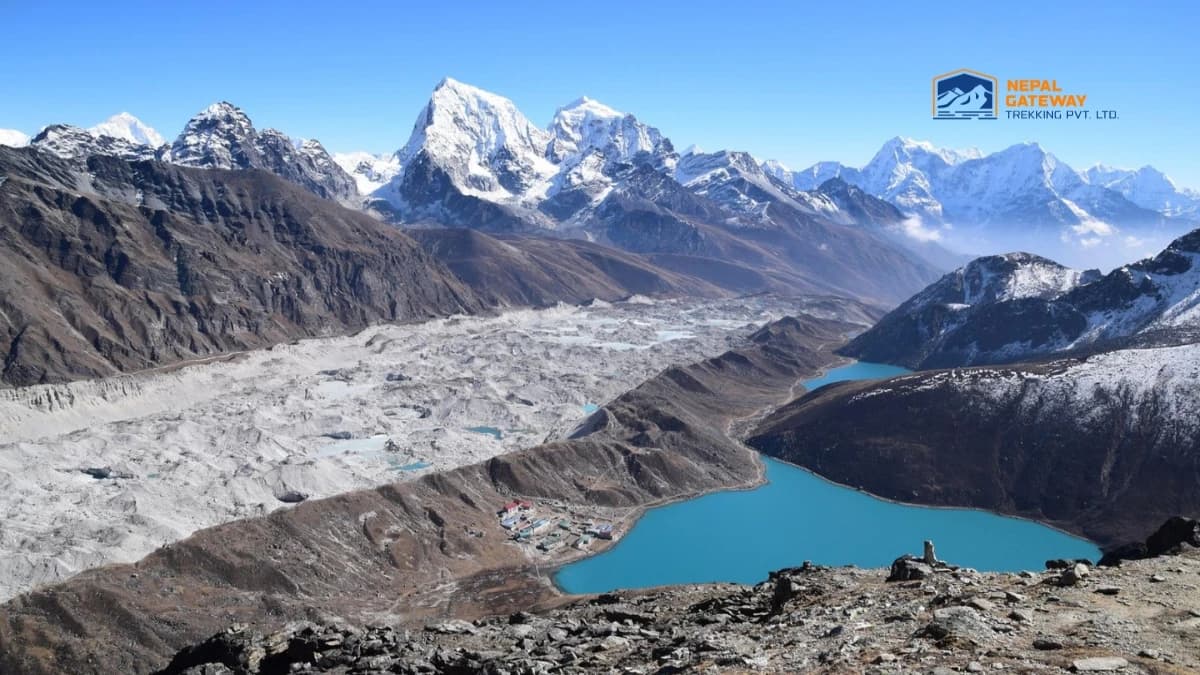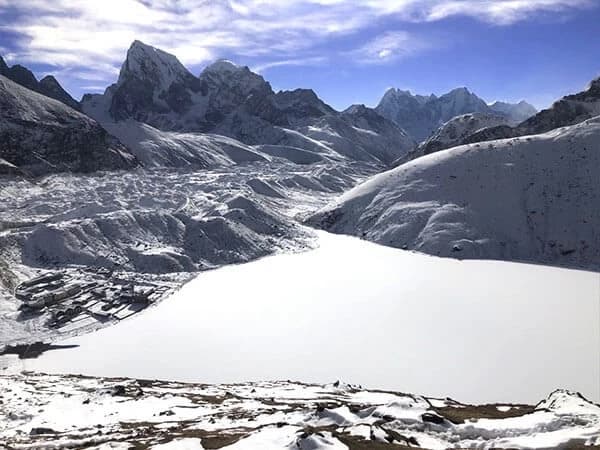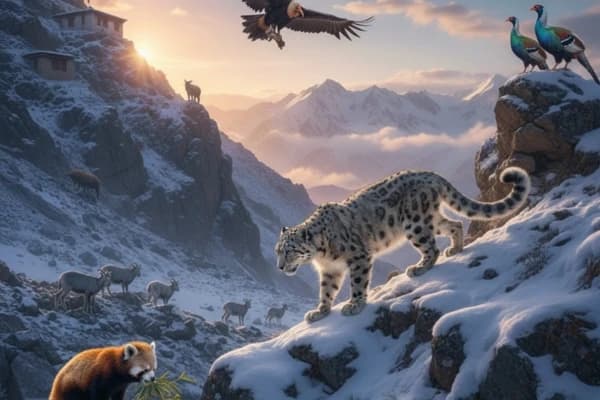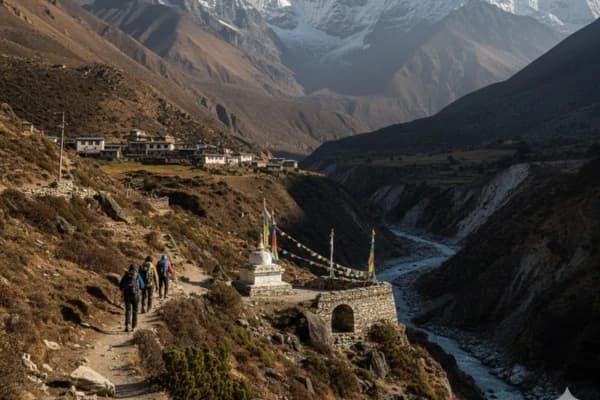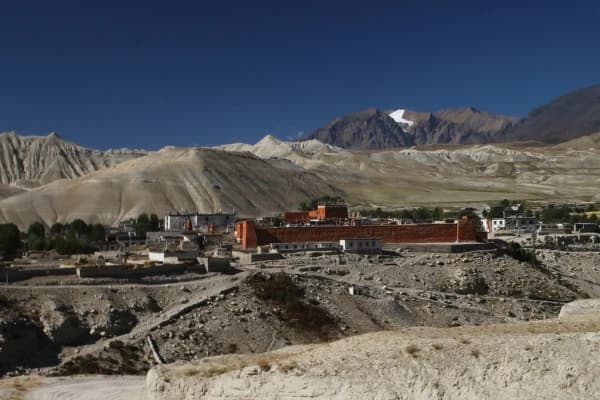Have you ever dreamed of walking beside a bright blue lake, with huge snow-covered mountains around you? That dream can come true at Gokyo Lake in Nepal. It’s one of the most beautiful places on Earth, and trekking there feels like stepping into a magical world. But before you pack your backpack, there’s one big question you need to ask: When is the best time to trek Gokyo Lake?
The truth is, this trek isn’t the same all year round. The weather, trail conditions, mountain views, and even how many other trekkers you’ll see depend on the season you go. Some months are perfect, with clear skies, warm sunshine, and stunning views of the Himalayas. Other times of the year can be cold, rainy, or foggy, making it harder to enjoy the beauty around you.
That’s why knowing the best time to trek Gokyo Lake is so important. It can turn your trek from “just okay” into something unforgettable.
In this full seasonal guide, we’ll walk you through what it’s like to trek in each season—spring, summer, autumn, and winter. Whether you’re someone who loves peaceful trails or bright blooming flowers, this guide will help you choose the time that’s just right for you.
Let’s get started and find out the best time to make your Gokyo dream come true.
Top Highlights that make the Gokyo Lake Trek Exciting

Let me explain why this hike is so unique before we go into the best time for the Gokyo Lake Trek. The highlights that truly made this journey unique are as follows:
The Beautiful Gokyo Lakes
Six beautiful lakes—Thonak Cho, Kyago Cho, Tanjung Cho, Ngozumpa Cho, Longabanga Cho, and Dudh Pokhari—are located high in the highlands. Their water is so clear and blue that it seems like a dream. These lakes are more than just beautiful; they are also considered sacred by both Hindus and Buddhists, which gives your trip a unique sense of tranquility and magic.
Ascending Gokyo Ri to Get the Greatest Views
Climbing Gokyo Ri is one of the trek's most exciting aspects. At around 5,360 meters, the view from the top is mind-blowing — you get a full 360-degree look at the Himalayas, including four of the world’s tallest peaks, like Everest. It’s honestly hard to put into words how incredible it is.
Walking Along the Ngozumpa Glacier
You’ll also walk next to the Ngozumpa Glacier, which is the longest glacier in Nepal. It truly puts the power of nature into perspective to see this enormous river of ice slowly flow down the mountain. It's a unique experience that is well worth the wait.
Getting to Know Sherpa Culture
You will travel through little Sherpa communities, including Gokyo and Namche Bazaar. Tradition, history, and friendliness abound in these settlements. Old monasteries can be visited, and residents are always willing to share their culture and experiences.
Crossing Renjo La Pass for the Adventure Seekers
The Renjo La Pass is a well-liked side trip if you want to challenge yourself a bit more. Although the climb is difficult, what about the views from the top? Stunningly beautiful. It's a fantastic method to provide even more significance to your journey.
Peace and Quiet Away From the Crowds
Compared to busier treks like Everest Base Camp, the Gokyo Lake Trek feels much more peaceful. You get to enjoy quiet walks, relaxing moments by the lakes, and a real chance to connect with nature without the crowds.
A Thrilling Start with the Lukla Flight
A quick flight from Kathmandu to Lukla, one of the most thrilling airports you'll ever land in, marks the start of your adventure! Flying over the Himalayas offers breathtaking sights that will excite you for the journey ahead.
Gokyo Lake Trek Experience in Different Seasons
When planning your adventure, knowing the best time to trek Gokyo Lake is very important. Each season offers a different experience on this beautiful trail. From snowy winters to colorful autumns and blooming springs, every time of the year brings its own unique charm. Understanding what to expect in each season will help you choose the perfect time to enjoy the trek safely and comfortably while making the most of the amazing views and culture along the way. You can also see the best trekking season in Nepal for most of the treks.
Let’s explore what the Gokyo Lake trek feels like through the seasons, so you can decide when is best for you!
Gokyo Lake Trek in Spring (March to May)

Spring (March to May) is one of the best times to trek to Gokyo Lake. The days are warm, the nights aren’t too cold, and the trail is full of life. Colorful rhododendrons bloom along the way, making the trek feel magical.
You’ll enjoy clear skies most days, which means amazing views of Everest, Cho Oyu, and other giant peaks. Since the winter snow has mostly melted by now, the paths are easier and safer to walk. Teahouses are open, and the trail is lively—but not too crowded.
If you want the perfect mix of beauty, comfort, and adventure, spring is a great season to go.
Pros
- Comfortable weather for trekking
- Beautiful rhododendron blooms
- Clear, stunning mountain views
- Safe, snow-free trails
- Longer daylight hours
Cons
- Can be crowded due to popularity
- Lodges may be busy
Gokyo Lake Trek in Summer (June to August)
Summer is warm in the Gokyo region, but it also means monsoon season. Heavy rain often makes the trails muddy and slippery, and the skies stay cloudy, hiding the mountain views most of the time.
Still, there’s a unique beauty to this season—the landscape turns lush and green, with wildflowers blooming everywhere. Plus, fewer trekkers are on the trail, so you’ll enjoy a quieter, more peaceful experience.
It’s not the best time to trek Gokyo Lake, but if you’re okay with wet conditions and want solitude in nature, summer might be worth it.
Pros
- Lush green scenery
- Fewer trekkers, peaceful trails
Cons
- Heavy rains and slippery trails
- Risk of landslides
- Clouds can block mountain views
- Some areas may be unsafe
Gokyo Lake Trek in Autumn (September to November)
Along with spring, autumn is often regarded as the ideal season to trek Gokyo Lake. The weather becomes stable and dry once the summer monsoon ends, with crisp, clear blue skies.
This time of year offers truly stunning views of the mountains, with snow-capped peaks that contrast sharply with the sky like a postcard. It is easy to walk and enjoy the journey worry-free because the trails are dry and secure.
With hikers from all over the world joining to take in the scenery, it's also a fun time on the trail. Autumn is the ideal season to visit if you want the most consistent weather and the greatest views of the mountains.
Pros
- Clear and dry weather
- Breathtaking mountain views
- Safe and dry trails
- Comfortable temperature
Cons
- Popular season can be crowded
- Lodges might be full
Gokyo Lake Trek in Winter (December to February)

The Gokyo region experiences frigid temperatures and a lot of snowfall during the winter, which makes the trek more challenging. Many teahouses close during this time, and snow may obstruct some sections of the walk.
However, winter offers a tranquil and quiet journey if you're prepared and experienced. The mountains are breathtaking beneath a new layer of snow, and the routes are almost deserted.
For most people, it's not the ideal time of year to trek Gokyo Lake, but for those who want to be alone and are prepared for the cold, it may be a magical, off-the-beaten-path experience.
Pros
- Quiet, less crowded trails
- Stunning snow-covered landscapes
- Clear mountain views
Cons
- Very cold temperatures
- Snow and ice on trails
- Some lodges may be closed
- Requires winter trekking experience
Explore the best time for Everest Base Camp Trek for more stunning views and weather conditions.
Seasonal Temperature Table
| Season | Months | Day Time Temp (in celcius) | Night Time Temp (in celcius) | Notes |
| Spring | March-May |
10°C to 20°C (Lower) |
0°C to 5°C (Lower) |
Rhododendron blooms, clear skies, mild weather |
|
5°C to 10°C (Gokyo) |
-8°C to -5°C (Gokyo) |
One of the best times to trek Gokyo Lake |
||
|
Summer |
June – August |
15°C to 25°C (Lower) |
5°C to 10°C (Lower) |
Monsoon rains, cloudy skies, lush greenery |
|
10°C to 15°C (Gokyo) |
0°C to 5°C (Gokyo) |
Trails may be slippery, leeches in forested areas |
||
|
Autumn |
September – Nov |
16°C to 24°C (Lower) |
-5°C to 5°C (Lower) |
Crisp air, clear views, high visibility |
|
10°C (Gokyo) |
-8°C (Gokyo) |
Another best time to trek Gokyo Lake |
||
|
Winter |
Dec – Feb |
Up to 10°C (Lower) |
-5°C to -10°C (Lower) |
Harsh cold, possible snow blockages |
|
Below 0°C (Gokyo) |
Below -10°C (Gokyo) |
Quiet trails, peaceful but challenging conditions |
How are spring and autumn the best Seasons For the Gokyo Lake Trek?
When choosing the best time to trek Gokyo Lake, most trekkers agree that spring and autumn stand out. These two seasons offer the perfect balance of weather, scenery, and safety, making your journey more enjoyable and memorable.
The trail wakes up in spring (March to May) with colorful rhododendron flowers blooming everywhere. The weather is pleasantly warm during the day and cool at night, which is great for hiking. Clear skies mean you get stunning views of Everest and other Himalayan peaks. Plus, the trails are mostly snow-covered, so walking is easier and safer.
In autumn (September to November), the monsoon rains have just ended, leaving the air fresh and clean. The skies are bright blue, offering some of the clearest mountain views you can imagine. Temperatures are comfortable—not too hot or cold—and the trails are dry and safe to walk on. This season is a favorite for many because the natural beauty shines, and trekking conditions are ideal.
Both seasons have their perks, but they also attract more visitors, so expect some crowds and busy lodges. Still, if you want the best weather, beautiful landscapes, and a safe trek, spring and autumn are definitely the seasons to plan your Gokyo Lake adventure.
So, Which Season Is Not Recommended?
Although each season has its own appeal, hiking can be challenging in the summer and winter. The trek's beauty may be diminished by the summer monsoon's frequent heavy rains, which make the routes slick and the vistas overcast.
However, if you're not used to hiking in cold weather, winter can be difficult and even dangerous due to the frigid temperatures and snow-covered routes. For a safer, more comfortable, and more pleasurable experience, most hikers choose to avoid these seasons when deciding when to trek Gokyo Lake.
Why Timing Matters for the Gokyo Lake Trek?
Let’s be honest—trekking to Gokyo Lake isn’t just another vacation. It’s a once-in-a-lifetime kind of journey. And when you’re investing your energy, time, and dreams into a trip like this, timing makes all the difference.
The best time to trek Gokyo Lake isn't just about catching the perfect weather (though that definitely helps). It's about being able to truly enjoy the beauty, the peacefulness, and the raw power of the Himalayas without battling extreme cold, rainstorms, or dangerous trail conditions.
During spring and autumn, the skies open up, the mountains look like paintings, and everything just feels right. You breathe easier, walk safer, and get to take in every stunning view with a calm heart.
But if you go during harsh winter or rainy monsoon season, the story changes. Trails can get risky, the views disappear into clouds, and even finding an open teahouse becomes tricky. That’s not the kind of challenge you want on a dream trek.
So yes, timing really matters. It’s the difference between a hard memory and a happy one. And if you want to make the most of your adventure, choosing the right season means setting yourself up for a smoother, more magical experience on the trail.
Thinking of another stunning trek in Annapurna Region? Explore our Annapurna Circuit Trek.
Packing Guide Based on Season for Gokyo Lake Trek

When planning your adventure, knowing the best time to trek Gokyo Lake is just the first step. Equally important is packing the essential things and gear for the season you choose. Each season brings different weather and trail conditions, so your packing list should change accordingly to keep you comfortable, safe, and ready for anything on the trail.
Spring (March to May)
Spring is one of the best times to trek Gokyo Lake, with mild weather and blooming rhododendrons.
- Clothing: Layered clothing — moisture-wicking base layers, a warm fleece or down jacket for mornings and evenings, and a waterproof shell.
- Footwear: Sturdy, waterproof hiking boots with good ankle support.
- Accessories: Sunglasses, sunscreen, a hat for sun protection, and trekking poles for stability.
- Other essentials: Light gloves, a warm hat, and a good daypack with rain cover.
Summer (June to August)
Summer means monsoon rains, so waterproof and quick-dry gear is a must.
- Clothing: Waterproof jackets and pants, quick-dry shirts and pants, and extra socks. Avoid cotton as it stays wet longer.
- Footwear: Waterproof hiking boots with a good grip to avoid slipping on muddy trails.
- Accessories: Rain cover for your backpack, insect repellent, and a wide-brimmed hat.
- Other essentials: Dry bags or zip-lock bags to keep electronics and clothes dry, trekking poles for slippery paths.
Autumn (September to November)
Autumn is another top trekking season with clear skies and cool weather.
- Clothing: Layered clothing including thermal base layers, a warm fleece or insulated jacket, and a windproof shell.
- Footwear: Waterproof hiking boots are ideal due to possible early snow at higher elevations.
- Accessories: Sunglasses, sunscreen, and a warm hat and gloves.
- Other essentials: Headlamp for early nightfall, trekking poles, and a reliable daypack.
Winter (December to February)
Winter trekking is for experienced adventurers prepared for cold and snow.
- Clothing: Heavy insulated jackets, thermal underwear, insulated gloves, and hats. Avoid cotton.
- Footwear: Insulated, waterproof boots suitable for snow and ice, plus crampons if needed.
- Accessories: Sunglasses or snow goggles, lip balm, and sunscreen (snow reflects UV rays).
- Other essentials: Trekking poles, hand and foot warmers, and a sturdy backpack with a waterproof cover.
If you are looking for best travel agency, explore Nepal Gateway Trekking who have been serving the best packages to travelers.
Packing smart according to the season will help you enjoy the best time to trek Gokyo Lake with confidence and comfort. Always check the weather forecast close to your trek dates and adjust your packing list as needed. Proper preparation is key to a successful and unforgettable trekking experience.
Conclusion
The best time to trek Gokyo Lake will depend on your intended experience. Whether it's the rich green but rainy summer, the crisp air and clear skies of autumn, the peaceful snowy walks of winter, or the colorful flowers and pleasant weather of spring, each season has something unique to offer. However, spring and fall remain the best seasons for weather, scenery, and trail conditions for most hikers.
No matter when you decide to explore this stunning part of the Himalayas, proper planning is key to enjoying a safe and memorable journey.
Get in touch with Nepal Gateway Trekking if you're prepared to embark on your journey or if you require professional advice on the ideal time of year, routes, and preparations. Their knowledgeable staff will assist you in creating the ideal excursion for your requirements.
Start your unforgettable Gokyo Lake trek today with Nepal Gateway Trekking!
FAQs
What is the best time to trek Gokyo Lake?
Gokyo Lake trekking is most enjoyable in the spring (March to May) and fall (September to November). Your walk will be safe and enjoyable during these seasons since they provide the finest mountain views, clear skies, and comfortable temperatures.
What is the Gokyo Lake trekking season?
The ideal Gokyo Lake trekking season includes spring and autumn, when the weather is stable and trails are dry. Summer brings monsoon rains, and winter is very cold with snow-covered trails, which can make trekking challenging.
What is the best season for the Gokyo Lake trek to get clear mountain views?
The best season for the Gokyo Lake trek to enjoy stunning, clear mountain views is autumn and spring. After the monsoon ends, autumn offers crisp, clear air, while spring brings blooming rhododendrons and mild weather.
How does the Gokyo trek weather guide help in planning the trek?
The Gokyo trek weather guide shows that spring and autumn have the most favorable weather for trekking, with moderate temperatures and less chance of rain or snow. Summer is rainy and slippery, and winter can be very cold and snowy, so planning according to the weather is important for safety.
What are the Gokyo Lake temperatures by month?
In general, daytime temperatures near Gokyo range from about 10°C to 24°C in spring and autumn, while nights can be close to freezing or below. Summer is warmer but wet, and winter temperatures can drop below -10°C, especially at night, making winter trekking challenging.
When to trek to Gokyo Lake for fewer crowds?
If you want to avoid crowds, trekking in the early spring (March) or late autumn (November) is a good choice. These times still offer great weather but fewer trekkers compared to peak months like April and October.
Can I trek Gokyo Lake in winter or summer?
You can trek to Gokyo Lake in winter or summer, but it’s not generally recommended. Summer has heavy monsoon rains, causing slippery trails and limited views, while winter brings freezing temperatures and snow, making the trek difficult and riskier without proper experience.
